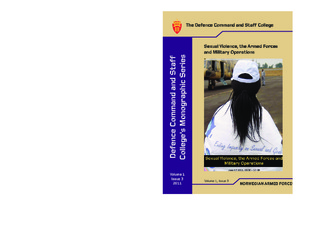| dc.description | The conference on “Sexual Violence, the Armed Forces and Military Operations,” arranged by the Gender Project at the Norwegian Defence University College in Oslo 17th of June 2011. By taping and transcribing the presentations, assisted and approved by the contributors, we are happy to offer a conference report. The report seeks to provide the insights and sentiments of the conference to those unable to attend, as if they were actually there.
The United Nations Security Council Resolution (UNSCR) 1325 (2000) on Women, Peace and Security has put gender on the international agenda. Since then, the international community has renewed its commitment to UNSCR 1325 by adopting UNSCR 1820 (2008), UNSCR 1888 (2009) and UNSCR 1960 (2010) on Sexual Violence in conflicts. They recognise sexual violence as a tactic of war, war crime and crime against humanity and call for preventive actions and ending impunity. Fulfilling these obligations requires adequate handling of sexual violence in military operations and the prevention of sexual harassment within the ranks. The international conference on Sexual Violence, the Armed Forces and Military Operations in Oslo, June 2011, offered a unique forum for experts and practitioners to discuss the interconnectedness between these issues and to draw implications for the armed forces.
Targeting military personnel, keynote speaker and UN Secretary General’s Special Representative on Sexual Violence in Conflict, Margot Wallström, urged:
“… As commanders, you have to make sure that the message is clearly conveyed that there can be no impunity for this type of crime. “This will not happen on my watch. You will be punished; you will be pursued if you commit such a crime.” We should also talk about men as victims, because today men and boys are among the victims of sexual violence; I still remember a young man who we met in the DRC in a panel where we interviewed for a reparation scheme. This young man told us that he did not even know about rape before. He was totally traumatized. He said: “I have nothing left. I have the shirt, the clothes that I have on my body, but that is all.” He lost his wife and his child, and is now totally lost in a world that he could no longer really understand and in deep shock over having been gang raped…
… It is not only, although it is still primarily, women or girls who are victims of sexual violence, but it is also boys and young men. Does this mean that we can mobilize more men to fight with us against sexual violence in war and conflict? I hope so… “ | |
